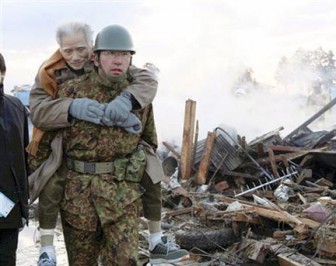TOKYO, (Reuters) – Japan confronted devastation along its northeastern coast today, with fires raging and parts of some cities under water after a massive earthquake and tsunami that likely killed at least 1,000 people.
Daybreak revealed the full extent of damage from yesterday’s 8.9 magnitude earthquake — the strongest in Japan since records began — and the 10-metre high tsunami it sent surging into cities and villages, sweeping away everything in its path.
“This is likely to be a humanitarian relief operation of epic proportions,” said Japan expert Sheila Smith of the U.S.-based Council on Foreign Relations.

The government warned there could be a radiation leak from nuclear reactors in Fukushima whose cooling system was knocked out by the quake. Prime Minister Naoto Kan ordered an evacuation zone expanded to 10 km (6 miles) from 3 km. Some 3,000 people had earlier been evacuated.
“It’s possible that radioactive material in the reactor vessel could leak outside but the amount is expected to be small, and the wind blowing towards the sea will be considered,” Chief Cabinet Secretary Yukio Edano told a news conference.
As authorities battled to contain rising pressure at the Fukushima facility, 240 km (150 miles) north of Tokyo, officials called for calm and said a meltdown remained unlikely.

The unfolding natural disaster prompted offers of search and rescue help from 50 countries.
China said rescuers were ready to help with quake relief while President Barack Obama told Kan the United States would assist in any way.
In one of the worst-hit residential areas, people buried under rubble could be heard calling out for rescue, Kyodo news agency reported. TV footage showed staff at one hospital waving banners with the words “FOOD” and “HELP” from a rooftop.
In Tokyo, office workers who were stranded in the city after the quake forced the subway system to close early slept alongside the homeless at one station. Scores of men in suits lay on newspapers, using their briefcases as pillows.

Kyodo said at least 116,000 people in Tokyo had been unable to return home on Friday evening due to transport disruption.
The northeastern Japanese city of Kesennuma, with a population of 74,000, was hit by widespread fires and one-third of the city was under water, Jiji news agency said on Saturday.
The airport in the city of Sendai, home to one million people, was on fire, it added.
TV footage from yesterday showed a muddy torrent of water carrying cars and wrecked homes at high speed across farmland near Sendai, 300 km (180 miles) northeast of Tokyo. Ships had been flung onto a harbour wharf, where they lay helplessly on their side.

Boats, cars and trucks were tossed around like toys in the water after the tsunami hit the town of Kamaishi. Kyodo news agency reported that contact had been lost with four trains in the coastal area.
Japanese politicians pushed for an emergency budget to fund relief efforts after Kan asked them to “save the country”, Kyodo reported. Japan is already the most heavily indebted major economy in the world, meaning any funding efforts would be closely scrutinised by financial markets.
Domestic media said the death toll was expected to exceed 1,000, most of whom appeared to have drowned by churning waters.

Even in a nation accustomed to earthquakes, the devastation was shocking.
“A big area of Sendai city near the coast, is flooded. We are hearing that people who were evacuated are stranded,” said Rie Sugimoto, a reporter for NHK television in Sendai.
“About 140 people, including children, were rushed to an elementary school and are on the rooftop but they are surrounded by water and have nowhere else to go.”
Japan prides itself on its speedy tsunami warning system, which has been upgraded several times since its inception in 1952, including after a 7.8 magnitude quake triggered a 30-metre high wave before a warning was given.
FIRES ACROSS
THE COAST

The quake, the most powerful since Japan started keeping records 140 years ago, sparked at least 80 fires in cities and towns along the coast, Kyodo said.
“I was unable stay on my feet because of the violent shaking. The aftershocks gave us no reprieve. Then the tsunami came when we tried to run for cover. It was the strongest quake I experienced,” a woman with a baby on her back told television in northern Japan.
Other nuclear power plants and oil refineries were shut down and one refinery was ablaze. Power to millions of homes and businesses was knocked out. Several airports, including Tokyo’s Narita, were closed and rail services halted. All ports were shut.
The central bank said it would cut short a two-day policy review scheduled for next week to one day on Monday and promised to do its utmost to ensure financial market stability.
The disaster struck as the world’s third-largest economy had been showing signs of reviving from an economic contraction in the final quarter of last year. It raised the prospect of major disruptions for many key businesses and a massive repair bill running into tens of billions of dollars.

The tsunami alerts revived memories of the giant waves that struck Asia in 2004.
The earthquake was the fifth most powerful to hit the world in the past century. It surpassed the Great Kanto quake of Sept. 1, 1923, which had a magnitude of 7.9 and killed more than 140,000 people in the Tokyo area.
The 1995 Kobe quake caused $100 billion in damage and was the most expensive natural disaster in history. Economic damage from the 2004 Indian Ocean tsunami was estimated at about $10 billion.





